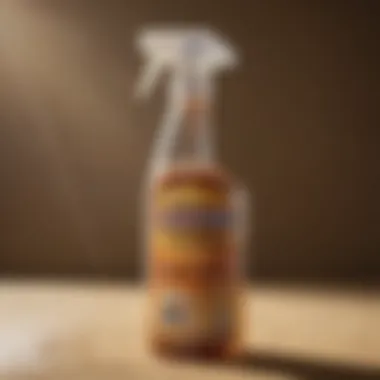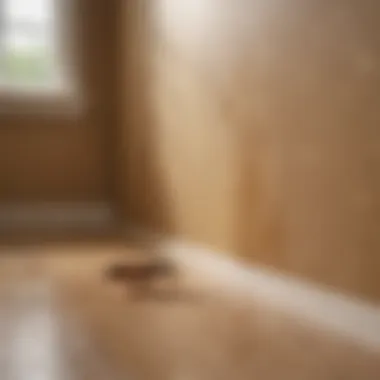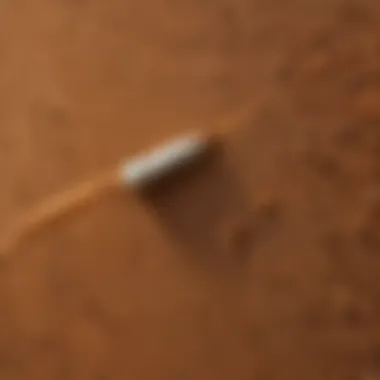Top Termite Sprays: Effective Solutions for Homeowners


Intro
Every homeowner knows that pests are part of the territory when it comes to owning a house. From pesky ants to bothersome rodents, dealing with these nuisances isn't just a matter of comfort; it's often about protecting one’s investment as well. However, when it comes to termites, the stakes are even higher. These little critters can silently wreak havoc, eating away at the very structure of your home.
Termites can cause considerable damage before you even notice they’re there. Often, by the time the signs are visible—such as mud tubes, hollowed-out wood, or droppings—extensive damage might already have occurred. So, being proactive is essential.
In this article, we will delve into the best termite sprays available, providing insights on their ingredients, effectiveness, and application methods. You’ll learn how to select the right products to safeguard your home against these destructive pests. As we explore this crucial topic, keep in mind that timely intervention can save you significant money and heartache.
Understanding effective termite control is paramount, particularly if you live in an area prone to infestations. By equipping yourself with the right knowledge and tools, you're getting ahead of any potential issues that could arise. Let’s jump into it.
Preamble to Termite Management
Termite management is a crucial aspect of home ownership and maintenance, particularly for individuals living in regions prone to termite infestations. These tiny pests can cause extensive structural damage, amounting to thousands of dollars in repairs, often without the homeowner’s knowledge until the situation has escalated. Understanding the dynamics of termite behavior, the types of termites, and how they invade homes lays the foundation for effective pest control strategies.
Termites are not just a nuisance; they can be a significant financial liability. It's estimated that homeowners across the United States spend close to $5 billion annually on termite control and repair services. Recognizing the signs of an infestation early on can save not only money but also peace of mind.
Homeowners should consider several elements when embarking on termite management, including:
- Knowledge of the types of termites: Different species can require different management approaches. For example, drywood termites chew through the wood in homes, while subterranean termites nest underground and may travel miles to find food.
- Awareness of environmental conditions: Certain environmental factors, such as moisture levels and wooden structures, can attract termites. Understanding these can help homeowners prevent infestations before they happen.
- Assessment of treatment options: With a range of termite sprays and other treatments available, knowledge of ingredients, effectiveness, and safety considerations is key. Selecting an appropriate spray tailored to the unique needs of the home can greatly influence outcomes.
In sum, effective termite management goes beyond just reacting to a problem. It's about proactive measures, informed decision-making, and ensuring that one's dwelling remains a safe haven.
Understanding the Termite Threat
Termites can be likened to an unseen enemy creeping in the shadows, ready to gnaw at your foundation. Estimates show that a colony of termites can consume up to one foot of wood in six months, translating to a constant risk of damage to homes over time. Each species of termite has distinct behaviors, making it pivotal to recognize the specific type that one is dealing with.
Most infestations begin with a queen termite laying thousands of eggs, leading to a rapidly growing colony. The worker termites then venture out, often undetected, in search of food sources which mainly include wood, paper, and other cellulose materials. By the time homeowners discover termit activity, significant damage could already be in play.
To ensure one’s home doesn't become a buffet for these pests, establishing routine inspections and staying vigilant about potential entry points is essential.
"An ounce of prevention is worth a pound of cure." This old saying rings especially true in the realm of termite management.
The Role of Termite Sprays
Termite sprays serve as a first line of defense against these wood-eating pests, and understanding their role can empower homeowners in protecting their investments. These products can be classified into several categories:
- Preventive Sprays: These sprays help create a barrier around the home. Applying them to the soil around your foundation can stop termites from ever getting close to your wood structures.
- Curative Sprays: If termites have already invaded, curative sprays can help eliminate them.
- Targeted Treatments: These products are specifically formulated to address identified threats. They can be essential in focusing on the exact problem without impacting the surrounding environment and helpful insects.
Choosing the right spray pertains not only to effectiveness but also to safety. Households with pets and children will benefit greatly from selecting products designed with a lower risk profile.
In summary, termite sprays act as multifaceted tools in the arsenal of termite management. With the right application techniques and an informed choice of product, homeowners can maintain the structural integrity of their homes while minimizing risk and expense.
Characteristics of Effective Termite Sprays


When it comes to tackling the persistent and often unseen threat of termites, understanding the characteristics of effective termite sprays is paramount for homeowners. Selecting the proper spray can mean the difference between a sound structure and a collapsing facade. This section will delve into the active ingredients that make these sprays effective and highlight critical safety considerations that should not be overlooked.
Active Ingredients to Look For
Active ingredients in termite sprays can vary significantly, and knowing which ones provide the necessary effectiveness is crucial. Not all sprays are created equal. Here are some key ingredients to keep an eye out for:
- Fipronil: Known for its strong neurotoxic effects on insects, Fipronil is effective in long-term control of termites. This ingredient disrupts the central nervous system of termites which leads to their demise.
- Imidacloprid: Similar in action to Fipronil, Imidacloprid is a neonicotinoid that targets insect nerve pathways. It’s effective at low concentrations and offers good residual activity.
- Trenbolone Acetate: A much less common active ingredient, Trenbolone works by disrupting growth and development in termites, making it effective for future infestations.
- Boric Acid: This is more of a natural option that can be used for treating wood. Boric acid affects the insect’s digestive system and can also act as a growth inhibitor.
Understanding the role these active ingredients play will help you make an informed decision about which termite spray aligns best with your needs. The effectiveness can vary based on the type of termite you are dealing with and the environment in which the spray is applied.
Safety Considerations
Just as you focus on effectiveness, safety cannot be swimmingly ignored when choosing a termite spray. Some sprays contain chemicals that may be harmful to humans and pets. Here are some safety tips to bear in mind:
- Follow Instructions: Always read and follow the product’s label. It provides important information about application rates, re-entry intervals, and safety precautions.
- Protective Gear: Wear gloves, masks, and goggles during application to shield yourself from possible chemical exposure. It’s one thing to keep your home termite-free and another to put your health at risk.
- Ventilation: Ensure the area is well-ventilated when spraying indoors. This helps dissipate any fumes that can linger in the air.
- Storing Products Safely: Keep all chemicals out of reach from children and pets. A locked cabinet is a good precautionary measure to consider.
"Safety first! You can't control termites if you're not in the best of health yourself."
In summary, the characteristics of effective termite sprays hinge primarily on their active ingredients and how safely they can be used in your home. By making an informed choice, you protect your residence and the health of everyone living in it.
Top Termite Sprays on the Market
When it comes to tackling the pesky issue of termite infestations, selecting the right spray holds paramount importance. This section shines a spotlight on the top termite sprays available today. By understanding the distinct characteristics, effectiveness, and user perceptions of these products, homeowners can make informed choices. What suits one person’s needs may not suit another’s, though. Therefore, knowing the ins and outs of these sprays is crucial for effective pest control. With various options available, weighing the pros and cons becomes an essential part of protecting one's home from structural damage.
Triflumuron-Based Sprays
Overview
Triflumuron-based sprays are becoming increasingly popular among homeowners dealing with termites. This type of spray works by disrupting the growth of the insect, effectively stopping them in their tracks. The key characteristic of triflumuron is its ability to inhibit chitin synthesis, which is necessary for termite growth. It’s a beneficial choice due to its long-lasting action and limited toxicity to humans and pets. A unique feature is that these sprays often target only specific pests, which means non-target species remain unharmed. This eco-friendly approach makes triflumuron a preferred option for those conscious about their pest management.
Effectiveness
In terms of effectiveness, triflumuron has been noted for its ability to provide gradual control of termite populations. Unlike some sprays that offer fast knockdown, triflumuron works over time, ensuring that the entire colony is affected. This characteristic is advantageous because it aims to eliminate termites before they can reproduce and cause further damage. Additionally, several studies indicate that when correctly applied, triflumuron can give homeowners a significant reduction in termite activity for months on end, making it a strong contender in termite management. However, it’s worth noting that this may not be ideal for urgent situations where immediate action is necessary.
User Reviews
When assessing user reviews for triflumuron-based sprays, a consistent theme emerges: effectiveness coupled with safety. Homeowners often commend its non-toxic nature and long-lasting effects, give it high marks for ease of use. A common sentiment shared among reviewers is the satisfaction of having a solution that doesn’t pose a risk to their pets or children while effectively controlling pests. Yet, some users caution that application might require patience, as the results are not instantaneous. Furthermore, occasional complaints surface regarding difficulty in finding these products in retail stores, which could potentially complicate immediate utilization.
Fipronil Formulations
Overview
Fipronil formulations have made a name for themselves in the termite spray market. This powerful insecticide is primarily known for its quick-acting nature against a variety of pests, including termites. The primary drawing card here is the effectiveness of fipronil as a broad-spectrum insecticide, which quickly attacks the nervous system of termites upon contact or ingestion. Its rapid knockdown capability makes it a popular choice among those facing severe infestations. One downside is that while it works fast, it might not provide the lasting effects some homeowners seek compared to other sprays.


Effectiveness
Fipronil’s effectiveness lies in its ability to create a barrier around the treated area. It not only kills termites but also repels them, reducing the chances of re-entry. This dual-action feature makes it particularly appealing. Users have frequently reported noticeable decreases in termite activity shortly after application. However, this rapid effectiveness comes with a caveat: if the application isn’t performed correctly or if the product isn’t reapplied when needed, the threat of re-infestation might loom. Thus, diligent follow-ups and monitoring are essential for maximized results.
User Reviews
User reviews for fipronil formulations often highlight immediate results and ease of application as key advantages. Many homeowners report satisfaction in watching termite populations dwindle within days of use. However, some users express concerns regarding price, noting that while the product does work well, it can be more expensive than other options. Another noted downside is the necessity for strict adherence to instructions; improper use can reduce effectiveness, leading to mixed reviews in certain cases. Still, the consensus generally leans towards fipronil being a reliable choice for those who deal with heavier infestations.
Microbial Products
Overview
Microbial products stand out for their unique approach to termite control, employing natural enemies of termites, such as nematodes and certain bacteria. The appeal of these sprays lies in their environmentally friendly characteristics. Homeowners looking for non-chemical options often gravitate toward microbial products. A major advantage is the ability of these sprays to break down quickly in the environment once applied, reducing any residual toxicity. However, these products generally work more slowly than chemical alternatives and might require multiple applications for effective pest control.
Effectiveness
In terms of effectiveness, microbial products excel by attacking termites on a biological level. The effects can sometimes take longer to manifest, with termites slowly dying off after ingesting the treatment. This delayed effect can be a double-edged sword; while it’s safer for the environment, it may not satisfy those looking for instant results. Reviews often point out that consistent application again is key to seeing a significant reduction in termite populations. Over time, these microbial products can prove quite effective in maintaining control of termite activity, particularly in conjunction with other pest management strategies.
User Reviews
The user reviews for microbial products often resonate around their natural formulation and safety for pets and humans. Customers appreciate the peace of mind that comes from using a product that claims to be safe and eco-friendly. However, some voices in the crowd express frustration over the slower action and the need for consistent reapplication due to its organic nature. Many users recommend these products for ongoing prevention rather than immediate extermination, positioning them as a part of a broader integrated pest management strategy.
Application Techniques
When it comes to managing termite infestations, the manner in which you apply your chosen termite spray cannot be overstated. Proper application techniques not only enhance the effectiveness of the product but also ensure the safety of your home and family. Just as one wouldn’t throw paint haphazardly on a wall and expect a masterpiece, applying termite spray requires thoughtful preparation and methodical execution. A well-planned application helps minimize the chances of leftover termite colonies, effectively protecting your space from future invasions.
In this section, we delve into the critical elements of preparing for application as well as providing a step-by-step guide for using termite sprays. Homeowners who diligently follow these guidelines stand a better chance against termite-related damage.
Pre-Treatment Preparation
Before you even think about spraying, laying the groundwork is essential. Think of preparation like setting the stage for a great performance; if the groundwork isn’t solid, everything that follows might fall flat. Here are some crucial steps for effective pre-treatment preparation:
- Assess the Infestation: Start by inspecting your property to understand the level and location of the termite problem. Look for mud tubes, damaged wood, or signs such as discarded wings to pinpoint their habitat.
- Choose the Right Products: Not all termite sprays are created equal. Depending on the species of termite and the extent of the infestation, you could need a specific formulation. A quick read of active ingredients can make all the difference.
- Gather Necessary Tools: Having a clean workspace makes things run smoothly. Grab gloves, protective eyewear, and a sprayer suitable for the type of product you’ve selected. Also, ensure a stable source of ventilation in the area you will be treating.
- Clear the Area: Move furniture and other obstacles to ensure you can spray into all the nooks and crannies. Termites love a good hideaway, so be sure to access their favorite spots!
- Read Instructions Carefully: Familiarize yourself with the specific instructions provided on the termite spray label. Ignoring guidelines can lead to ineffective treatment.
By taking these preparatory steps, you set yourself up for a successful application.
Step-by-Step Application Guide
Like assembling a puzzle, termite spray application requires care and precision. Here’s a straightforward step-by-step guide to ensure you’re doing it right:
- Mix the Product: If your termite spray requires dilution, follow the manufacturer's recommendations to the letter. Too much or too little can affect performance.
- Test a Small Area: Before going all out, test the spray on a small, inconspicuous area of wood. This helps confirm that it won't cause any damage or adverse reactions.
- Start Applying: Hold the sprayer about a foot away from the surface. Spray in sweeping motions to evenly distribute the product. Focus on areas where you detect termite activity, particularly around foundations, entry points, and wooden structures.
- Cover All Bases: Don't neglect potential entry points such as cracks, gaps, and even the interior of wooden beams. Even small openings can allow termites access to your home.
- Allow to Dry: Let the treated areas dry completely. It’s vital for the chemicals to settle and take effect fully. Encourage airflow by opening windows, if possible.
- Follow-Up Inspections: After a week or two, check the treated areas to verify that the treatment was effective. If termites are still present, further action may be necessary.
"When it comes to termite control, often literally the devil is in the details. Attention to each step ensures the health of your home."


By adhering to these procedures, you’ll stand better equipped to tackle the issue effectively. With meticulous planning and execution, you can lay down a formidable defense against those wooden munchers.
Eco-Friendly Alternatives
In today's world, there's a growing consciousness about the environment, urging homeowners to seek out solutions that won't add to their ecological footprint. This is especially true when it comes to pest control, as many traditional termite sprays involve potent chemicals that not only target pests but can also pose risks to humans and pets. Hence, eco-friendly alternatives emerge as crucial options for those looking to rid their homes of termites while being mindful of environmental impacts.
Choosing natural and eco-friendly solutions enables you to address termite issues responsibly. These options often rely on biodegradable ingredients, minimizing adverse effects on local ecosystems. Moreover, opting for these methods reflects a commitment to sustainable living, contributing to a healthier planet for future generations. Here are a couple of essential points to consider when exploring eco-friendly alternatives for termite control:
- Less Toxicity: Natural insecticides are less likely to leave harmful residues in your home, thus reducing health risks for residents.
- Sustainability: Many of these products utilize components derived from plants, which are renewable resources, contributing to sustainable pest management.
- Effectiveness: Recent studies indicate that some natural treatments can be quite effective against termites, proving that eco-friendly choices do not always mean compromising efficiency.
In short, integrating eco-friendly alternatives in your termite management plan can not only protect your home but also contribute positively to the environment. Let's take a closer look at some effective natural solutions as well as integrated pest management strategies.
Preventive Measures Against Termite Infestation
The bane of homeowners everywhere, termites are crafty little critters that can wreak havoc on structures if given the opportunity. Therefore, preventive measures are not just beneficial but essential in the fight against these wood-chomping intruders. Looking after your home isn’t just about remedying issues once they arise; it’s about creating an environment that discourages termites right from the get-go.
Adopting a proactive stance can save you a heap of trouble and potential costs down the line. Prevention can often be the simplest solution, for as they say, "An ounce of prevention is worth a pound of cure." Here’s an overview of what homeowners can do to keep these pesky insects at bay.
Home Maintenance Tips
Maintaining your home may seem like an endless chore, but it’s a crucial line of defense against termites. Here are some practical tips:
- Seal Entry Points: Inspect your home for cracks and crevices in the foundation, walls, and around windows and doors. Use caulk or foam insulation to seal these entryways to thwart termites.
- Keep Wood Away from Soil: Make sure that firewood, lumber, and any wooden materials are stored at least 20 feet from your home’s foundation.
- Proper Drainage: Ensure your gutters are clean, and water drains away from the foundation. Termites are drawn to moisture, so it’s best to keep your home dry.
- Routine Lawn Care: Regularly trimming back shrubs and trees helps in reducing the risk of termites making a home in your garden close to the house.
- Subterranean Barriers: If you live in an area prone to termite infestations, consider creating a physical barrier, such as a steel mesh or sand barrier, during any renovations or constructions.
Being consistent with these tips can greatly reduce the risk of termite infestation.
Regular Inspections and Monitoring
Conducting regular inspections is a critical strategy in preventing termite infestations. After all, it’s better to catch these pests early than to deal with extensive damage later. Consider the following:
- Frequency: Schedule annual professional inspections and conduct periodic self-checks. Look for mud tubes, discarded wings, or even the sound of crunching wood when tapped.
- Use Technology: Consider investing in monitoring systems that use sensors to detect termite presence in key areas of your property.
- Stay Informed: Follow local pest control forums, such as Reddit or Facebook, to learn about any outbreaks in your area, or trends that may affect your community’s termite risk.
"Forewarned is forearmed."
Being vigilant and proactive with inspections can keep you a step ahead. Keeping termites in check isn't just about eliminating them; it’s about creating a comprehensive strategy that includes routine oversight.
In summary, while termite sprays are essential tools in pest management, effective prevention techniques empower homeowners to take back control, minimizing future costs and stress. A well-kept home, along with consistent inspections, makes it harder for these unwanted pests to thrive.
Culmination
When it comes to safeguarding one’s home against the relentless threat of termites, a solid conclusion wraps up the insights gleaned throughout this guide. Understanding the best termite sprays isn't merely about picking a product off the shelf; it involves a deeper awareness of the strategies and practices that can drastically improve one’s odds against an infestation.
Homeowners must reassess their termite defense strategies periodically. This means not only relying on sprays but also considering a multi-faceted approach. Each spray discussed earlier possesses its strengths, and realizing which situations call for which type is key. There is no one-size-fits-all here; a blend of preventative measures, timely applications, and observant monitoring often yields the best results.
"An ounce of prevention is worth a pound of cure." This adage rings especially true in termite management. By integrating regular checks into home maintenance and staying informed about the latest products, homeowners can stay a step ahead of these destructive pests.
The benefits of being proactive cannot be overstated. Not only does it save homeowners from the heartache and financial strain of dealing with extensive damages, but it also brings peace of mind. Utilising the right termite spray coupled with home upkeep and vigilance can lead to a fortified home ready to withstand infestation.
Ultimately, reassessment isn't a one-time task; it’s an ongoing commitment to excellence in termite defense. As pest control technologies evolve and new products are introduced, staying updated means consistently evaluating which sprays to trust and how best to apply them. By actively engaging in termite management, you not only protect your investment; you're also fostering a safe and secure living environment for your family.
In this battle against termites, information is power, and the wise homeowner remains informed, ready, and resilient.



